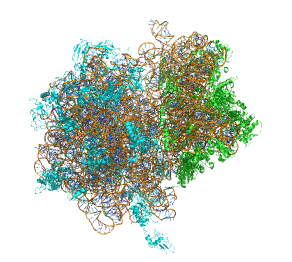- Home
- News
- General News
- Two long-term users...
Two long-term users of the ESRF win the Nobel Prize in Chemistry
07-10-2009
Ada Yonath, from the Weizmann Institute (Israel) and Venkatraman Ramakrishnan, of the MRC Laboratory of Molecular Biology in Cambridge (UK), both ESRF long-term users, have been awarded the Nobel Prize of Chemistry 2009. The award is given for the study of the structure and function of the ribosome, the protein factory in the cell. They will share the prize with Thomas Steitz, from Yale University (US).
Share
The two scientists have been regular users of the structural biology beamlines at the ESRF since the early days of the facility and Ada Yonath is, at present, also a member of its Science Advisory Committee.
The seven structural biology beamlines at the ESRF have evolved throughout the years and turned into automated machines, partially thanks to feedback from Yonath and Ramakrishnan and their groups. "Their research helped to push the automation and sample evaluation methodology at the ESRF", said Sean Mc Sweeney, head of the Structural Biology group at the ESRF. "The challenge of the project they had was so huge that it kept us thinking of new developments in order to make it fruitful", he adds. Venkatraman Ramakrishnan even lent crystals to the ESRF staff in order to improve the on-line sample evaluation. Today, the teams of both winners come once a month to the ESRF on average and they analyse around 500 samples every time.
 |
|
A representation of the very highly complex ribosome structure. |
The ribosome structure has potential for the development of new drugs. It is known that some important antibiotics act upon the ribosome and the laureates have been awarded for their work in exploring/studying these interactions. Startup companies focused on drug discovery using the high resolution crystal structures of the ribosome aim to develop novel drugs which avoid antibiotic resistence mechanisms. The companies Rib-X and Ribotargets have come to the ESRF to carry out proprietary research on the beamlines, which shows the contribution in applied research of this synchrotron source. Rib-X Pharmaceutical, co-founded by Steitz, currently have potential drugs in clinical trials.
"Unravelling the structure of the ribosome is the result of an effort started nearly 30 years ago. The decisive final data sets were only taken in the second half of the 1990s at two synchrotron radiation sources, the ESRF in Grenoble and APS in Chicago in the United States. We are very proud for having contributed to these important results which would not have been possible without specialised instruments and dedication by our scientists at the ESRF" says Francesco Sette, Director General of the ESRF. He adds: "I am confident that this year’s Nobel Prize will also not be the end. In addition, it illustrates the contribution that the European institutes are making to attract frontline research and the best scientists worldwide to Grenoble."
Ramakrishnan and Yonath were already awarded the Wolf Prize in 2007 for their work on ribosomes (read the story here) and Yonath received the L'Oreal-UNESCO Women for Science award last year (read the story here). Ada Yonath is the fourth woman to ever be awarded the Nobel Prize of Chemistry, the last being Dorothy Hodgkin in 1964, also a crystallographer.
Top image: V. Ramakrishnan and A. Yonath.



